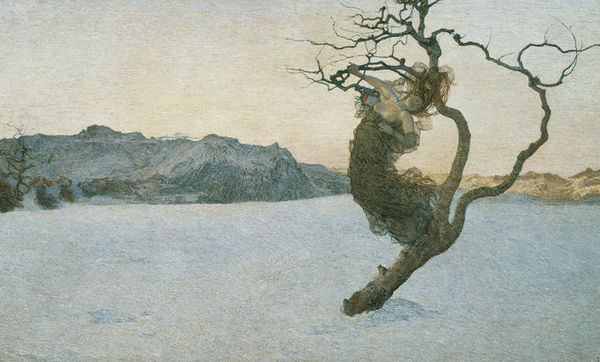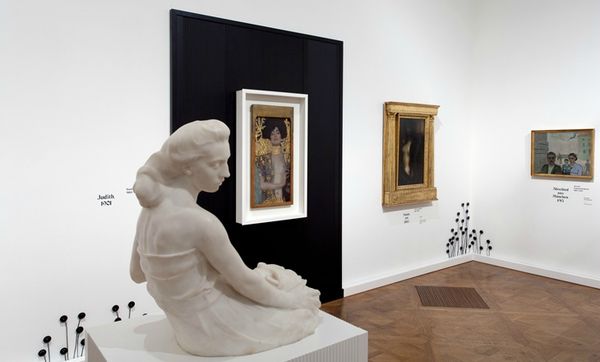"Decadence: Aspects of Austrian Symbolism" at the Lower Belvedere
Gustav Klimt, Sonja Knips, 1897/1898. Oil on canvas, 145 x 146 cm© Belvedere, Vienna.
VIENNA.- This is the first time that the Belvedere highlights the multifaceted positions of Austrian Symbolism in a major exhibition. As a first step towards a long-overdue review of this highly significant movement in Austrian art around 1900, which has hitherto almost exclusively been analyzed from partial aspects, the show offers an overview of the development of the Symbolist approach in Austria and Central Europe. Presenting a diversified compilation of artistic viewpoints on a number of themes, Decadence - Aspects of Austrian Symbolism illustrates a large spectrum of styles and personal ways of expression. An artistic intervention by the Canadian composer and installation artist Robin Minard expands the visual and acoustic experience of the exhibition, so that the show also takes into account the interdisciplinary aspirations of this art movement.
Symbolism as a Point of Departure for Modernism
“Although it provided the basis for relevant movements of the twentieth century, such as for Magic or Fantastic Realism during the interwar and postwar years, Symbolism was viewed with disfavour in the art world. The fantastic and exuberant were considered obsolete, irrational, and decadent. Yet it was particularly in Austria that this genre, which has long been neglected, played a central role in the evolution of Modernism. Developing from the spirit of décadence, it discovered for itself a cryptic aestheticism of decay, mysticism, and enigma as early as the 1870s,” Agnes Husslein-Arco, director of the Belvedere, explains. For their Expressionist works, both Egon Schiele and Oskar Kokoschka drew on Symbolism, while works by Gustav Klimt or Koloman Moser are based on Symbolist thought; the movement even proved crucial for the development of abstract painting, as becomes evident, for example, in the oeuvre of František Kupka.
In Search of Means to Express Sensuality, Magic, and Profoundness
Looking for a way out of the pomp of Historicism and the superficiality of Naturalism, the young generation of artists went in search of a new way of expression that would represent sensuality, magic, and profoundness. Its members fathomed the mysteries of mythology and mysticism, creating their own modern myths. Ostentatious historicist painting gave way to a focus on subjective views of the inner mind rendered in a suggestive language of colour and form. This abandonment of reality led some artists to idyll and others to cosmic visions. It was primarily via the Vienna Secession that such artists as Max Klinger, Franz von Stuck, Fernand Khnopff, and Jan Toorop disseminated this aesthetic approach throughout Austria and Central Europe. “Decadence - Aspects of Austrian Symbolism illustrates how, in the context of the fin de siècle, the approach of décadence led to the dissolution of traditional aesthetic norms in favour of a liberal and creative experimentation with the possibilities of pictorial representation. Since Symbolism embraced several styles on the one hand and also extended to such genres as literature, poetry, and music on the other, it is a mindset rather than style,” Alfred Weidinger, vice-director of the Belvedere and curator of the exhibition, points out. Symbolism’s interdisciplinary character culminated in the emergence of the Secessionist Gesamtkunstwerk or total work of art, the concept of which is also integrated into the exhibition in the form of an acoustic intervention by the Canadian composer and installation artist Robin Minard, who harks back to a graphic ornament used in the Secession’s exhibitions with the aid of 2,000 loudspeakers, drawing his inspirations from Symbolist music, literature, and poetry.
A Symbolist Imagery between Vision and Suggestion: the Gesamtkunstwerk
Along such themes as From Allegory to Symbol, Faces- Bodies - Landscapes, Fin de Siècle and Golden Age, The Woman as a Symbol, Between Underworld and Universe, and Richard Wagner and the Symbolists, the show presents works by Gustav Klimt, Egon Schiele, Giovanni Segantini, Gustave Moreau, Max Klinger, Arnold Böcklin, Jan Toorop, Fernand Khnopff, Alfred Kubin, Franz von Stuck, Luigi Bonazza, Wilhelm Bernatzik, Wilhelm List, Maximilian Lenz, Erich Mallina, Rudolf Jettmar, Eduard Veith, Frantiek Kupka, Maximilian Pirner, Karl Mediz, Arnold Clementschitsch, Koloman Moser, Wenzel Hablik, Ernst Stöhr, Oskar Kokoschka, and other artists.
The theme From Allegory to Symbol illustrates how the Symbolist image – unlike classical allegory, which is based on convention and can be grasped intellectually – is aimed at making a suggestive impact and puts sensual experience before rational knowledge by juxtaposing the banalities of reality to myth and mysticism.
Faces – Bodies – Landscapes addresses the preoccupation of artists with their subjective views of the world. Through the renunciation of naturalistic representation, artistic means of design can be employed as vehicles of expression, so that the treatment of the face, body, and nature in portraiture, nude painting, and landscape art turn out to be a quest for insight.
The focus of Fin de Siècle and Golden Age is on the Symbolist continuation of the melancholy, atmospheric landscape of Romanticism. Many artists felt hypercivilization to be a burden; they craved for a simple life and fathomed the relationship between man and his environment.
The section The Woman as a Symbol visualizes how the central role of the woman as an allegorical figure takes on new significance in Symbolism. Traditionally associated with sensuality and mystery, the woman offers herself as an ideal figure of projection – her roles, oscillating between saint and whore and between femme fragile and femme fatale, are rendered in all of their facets and enriched by new aspects.
Between Underworld and Universe demonstrates how death as a transition from worldly to eternal life functions as a perfect metaphor for the Symbolists’ objectives: from the trivialities of everyday life to the mysteries of the hereafter, to heaven and hell, to the netherworld and cosmic realms, beyond time and space.
Finally, Richard Wagner and the Symbolists illustrates how Wagner’s vision of the total work of art and his Ring of the Nibelung, his opus magnum first performed in 1876, supplied an inexhaustible repertoire of inspiring motifs and an opportunity of plunging into a romantic underwater realm that had hitherto only existed in music and literature. It can thus be said that Wagner’s work was probably the source of the most relevant contributions made by Austrian Symbolism.
Adolf Hiremy-Hirschl, The Souls At Acheron, 1889 © Belvedere, Vienna
Giovanni Segantini, Die bösen Mütter, 1894 © Belvedere, Vienna
Karl Mediz, Red Angel, 1902. Oil on canvas, 172 × 185.5 cm© Private collection, Vienna
Exhibition view, 2013 © Belvedere, Vienna
Exhibition view, 2013 © Belvedere, Vienna
Exhibition view, 2013 © Belvedere, Vienna
Exhibition view, 2013 © Belvedere, Vienna
Exhibition view, 2013 © Belvedere, Vienna

/https%3A%2F%2Fprofilepics.canalblog.com%2Fprofilepics%2F1%2F0%2F100183.jpg)
/https%3A%2F%2Fstorage.canalblog.com%2F03%2F02%2F119589%2F96711876_o.jpg)
/https%3A%2F%2Fstorage.canalblog.com%2F11%2F31%2F119589%2F94773502_o.jpg)
/https%3A%2F%2Fstorage.canalblog.com%2F20%2F83%2F119589%2F94772815_o.jpg)
/https%3A%2F%2Fstorage.canalblog.com%2F26%2F72%2F119589%2F75604929_o.jpg)
/https%3A%2F%2Fstorage.canalblog.com%2F59%2F60%2F119589%2F26458628_o.jpg)











/http%3A%2F%2Fstorage.canalblog.com%2F04%2F34%2F119589%2F126029126_o.jpg)
/http%3A%2F%2Fstorage.canalblog.com%2F78%2F18%2F119589%2F122525383_o.jpg)
/http%3A%2F%2Fstorage.canalblog.com%2F05%2F02%2F119589%2F121570920_o.jpg)
/http%3A%2F%2Fstorage.canalblog.com%2F53%2F17%2F119589%2F120956167_o.jpg)